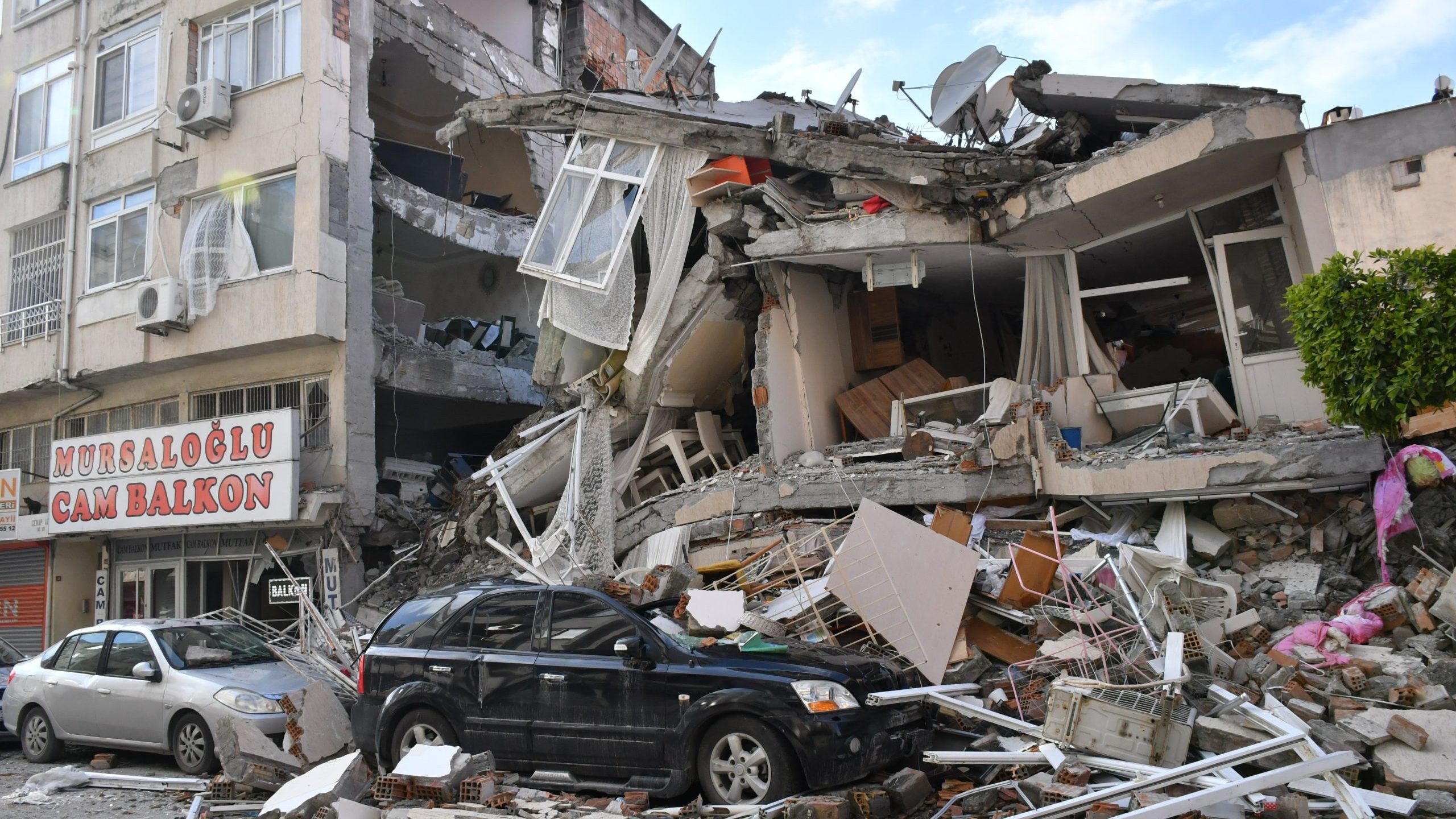
This report is sent from Gaziantep, southeast Türkiye, 15 March 2023.
A 7.8 magnitude earthquake struck southeast Türkiye near the Syrian border on 06 February 2023 at 4:17am local time, with its epicentre near Nurdağı and Gaziantep in Gaziantep Province. Shortly afterwards, on the same day, a second earthquake of 7.7 magnitude subsequently struck the same region 100 kilometres to the north of the first epicentre.1 As of 07 March 2023, 51,968 earthquake-related deaths have been reported across Türkiye and northwest Syria, and 224,000 buildings across the countries have collapsed, been heavily damaged, or been otherwise rendered inhabitable and in urgent need of demolition.2
The effects of the earthquakes on child health in Türkiye are substantial, multifaceted and, without urgent intervention, deeply enduring throughout the life course.
An estimated 9.1 million people have been directly affected by the earthquakes,3 including some 3.7 million children.4 3.8 million of those people have been displaced due to the resulting loss of suitable shelter, disruption to water, sanitation and hygiene (WASH) facilities, and deficiencies in food security, along with interruptions to the provision of health services, education, infrastructure, economies, and livelihoods.4 Across the region, some 850,000 children have been displaced by the disaster, and currently reside in temporary accommodation,5 which constitute government-coordinated displacement sites (tent and container cities, and emergency shelters in public buildings), informal/makeshift settlements, or private solutions. Specifically within Türkiye, some 484 government-coordinated tent and container cities, which collectively house 1.4 million internally displaced people (IDP) – including hundreds of thousands of children – have been established across 11 affected provinces, while 85,000 IDP reside in government-coordinated community shelters such as universities buildings and institutional dormitories.3
The effects of the earthquakes on child health in Türkiye are substantial, multifaceted and, without urgent intervention, deeply enduring throughout the life course. Similar impacts are largely expected to have been afforded to the children residing in northwest Syria, although the country’s current political situation presents significant challenges to the accrual of timely and accurate data on the situation’s development within the country (the on-going war in Syria has already impacted enormously on the health and wellbeing of children, and the response to the earthquakes that has been delivered to date has been widely condemned).6
The impacts of the earthquakes to child health and wellbeing can be broadly categorized into five categories: impacts of injuries, psychological impacts, physical health impacts, protection risks, and educational impacts.
Impacts of injuries
Beyond the tragic number of fatalities, 118,700 earthquake-related injuries have also been reported across Türkiye and Syria, a large proportion of which were sustained by children.2 These injuries were either the direct result of the earthquakes themselves – sustained during the destruction of buildings that children were inside or proximate to – or their indirect effects, such as injuries sustained by children while extracting themselves from collapsed structures, traversing over unstable wreckages, or attempting to rescue their loved ones or retrieve their possessions from beneath the rubble. The severity of these injuries ranges from minor and self-limiting muscular and soft tissue wounds to significant head injuries, chest and abdominal trauma, crush injuries, and amputation of limbs. For many children, their injuries will have profound and permanent repercussions that will have negative impacts on their physical health, psychological wellbeing, social functioning, and economic prosperity for the rest of their lives. The importance of the early provision of high quality, long-term rehabilitation services to promote functional recovery, shorten hospital stays, and reduce the incidence of complications or disability in all individuals injured by earthquakes, especially children,7 is well recognised and is now urgently required in regions affected by the earthquakes.
Psychological impacts
The potential for adverse childhood experiences, such as exposure to traumatic events and violence, to harmfully affect a child’s developmental trajectory and increase the risk of physical and mental illnesses later in their life course is increasingly recognised.8 Living through a natural disaster, such as a devastating earthquake, in which their own lives are seriously endangered (many children were stuck under the rubble for hours and even days), their parents, wider family and friends are traumatically killed or seriously injured, and their homes and communities are destroyed such that they are rendered homeless and required to relocate, clearly constitute adverse childhood experiences and, thus, threaten both the physical and psychosocial health of the children that experience them. In addition, a foundational protective factor to child mental health and wellbeing is a relationship with the primary caregiver that is secure, warm and nurturing.9 In the extreme context of the earthquakes, parenting and caregiving may be severely compromised as surviving caregivers manage their own responses to trauma and the challenges to providing even basic necessities. It is recognised that supporting caregivers during such crises both reduces the risk of child maltreatment, and is an essential protective factor against the development of behavioural and emotional problems in the children under their care.10 It is also understood that the addition of evidence-based parenting skills components has the potential to magnify the benefits of interventions designed to enhance children’s psychological wellbeing in contexts of trauma and displacement.11
Physical health impacts
The impacts of the earthquakes to child health and wellbeing can be broadly categorized into five categories: impacts of injuries, psychological impacts, physical health impacts, protection risks, and educational impacts.
The displacement sites that now accommodate hundreds of thousands of children displaced by the earthquakes present challenging living conditions for all those that reside within them, particularly children. Overcrowded tents, containers and community shelters located within densely populated displacement sites, and inadequate provision of suitable water, sanitation and hygiene facilities, increase the likelihood of communicable disease outbreaks.3 The author has consulted with and treated many children suffering with viral gastroenteritis, respiratory tract infections, and scabies infestations, which are often transmitted between the child’s entire household that now resides within the same tent, container or emergency shelter. In addition, the availability of accessible healthcare facilities is often suboptimal within these displacement sites,3 while the pre-existing Turkish health system, and its ability to deliver high quality and timely clinical care, has been profoundly impacted by the earthquakes and their aftershocks (for example, 15 hospitals and hundreds of pharmacies have been rendered unusable within Türkiye alone).3 Accordingly, the management and control of chronic and non-communicable diseases, screening programmes, maternity and neonatal care, surgical services, and primary care (which largely takes place in hospital-based polyclinic settings) has been severely impeded, and will assert substantial negative effects on the physical health and psychological wellbeing on millions of children in the areas affected.
Protection risks
The author has consulted with and treated many children suffering with viral gastroenteritis, respiratory tract infections, and scabies infestations, which are often transmitted between the child’s entire household that now resides within the same tent, container or emergency shelter.
The risks of child maltreatment – including the abuse and trafficking of, and violence towards, children and adolescents – during disasters and emergencies are well recognised.12 In the context of the Türkiye earthquakes, a key action in the prevention of mistreatment of children is to identify those that are unaccompanied or have otherwise been separated from their families, and take steps to urgently reunify them with their loved ones, or continue to protect them if their families did not survive the disaster or are untraceable. While displacement sites offer a large number of benefits to the health and wellbeing of IDPs (through the centralised and mass provision of urgently needed shelter, food security, heating fuel, and cash assistance for hundreds of thousands of displaced individuals), they also pose a protection threat to children, particularly those who are unaccompanied or otherwise separated from their families. As such, the need for safe spaces, such as gender-segregated facilities designed to minimise child protection and gender-based violence risks, has been frequently identified within these sites.3 The immediate and long-term impacts of childhood maltreatment on child health, which extend deep into the life course and are particularly harmful to psychological development and mental health in adulthood, have been widely established.13
Educational impacts
An estimated 1,800 schools have been significantly damaged by the earthquakes, and at least 171 of these are now being used as emergency shelters for IDP.4 As a result, the educational attainment of children registered at these schools has been, and will continue to be, indefinitely paused until these buildings are rendered safe and available to be used for educational purposes. For many other children whose school buildings have not been seriously damaged, school attendance is also postponed due to personal injury, loss of their homes and possessions, relocation to displacement sites, or the injury or death of one or both of their primary caregivers. The harmful long-term effects of interruptions to education on the physical, mental, emotional, and economic health of children is well recognised.14
Conclusion
The recent earthquakes close to the Syrian border in southeast Türkiye constitute a profound constellation of adverse childhood experiences that some 3.7 million children stand to be affected by. This disaster poses a staggering risk to the physical and psychological health of those children, both in the immediate term and throughout their development across the full life course into adulthood. More immediately, the disaster has posed, and continues to incur, severe risks to the health and wellbeing of children – particularly those that are unaccompanied or separated from their families – through the impacts of injuries, communicable diseases, interruptions to healthcare provision, psychological reactions, protection risks, and educational disruption. Accordingly, the coordinated and multiagency response to the disaster15 – that should incorporate the most effective, safe, and evidence-based interventions for positive outcomes in such contexts – in both southeast Türkiye and northwest Syria (which provides additional challenges to access and security beyond those encountered in Türkiye), must be adequately funded and sufficiently scaled up to successfully reach, fully support, and adequately safeguard the health of each and every one of the children affected by the disaster.
References
- ReliefWeb. Situation Report: Syria Earthquake March 2023 Government-Controlled Areas, Bi-Weekly Highlights – 03/03/2023. https://reliefweb.int/report/syrian-arab-republic/syria-earthquake-march-2023-government-controlled-areas-bi-weekly-highlights-03032023 [accessed 15 March 2023]
- USAID. Türkiye and Syria – Earthquakes Fact Sheet #10, Fiscal Year (FY) 2023 (March 7, 2023). 07 March 2023. https://reliefweb.int/report/turkiye/turkiye-and-syria-earthquakes-fact-sheet-10-fiscal-year-fy-2023-march-7-2023 [accessed 15 March 2023]
- ReliefWeb. Situation Report: Türkiye Earthquake February 2023, Bi-weekly Highlights – 03/03/2023. https://reliefweb.int/report/turkiye/turkiye-earthquake-february-2023-bi-weekly-highlights-03032023
[accessed 15 March 2023] - Unicef. Earthquake response: Humanitarian situation report: 21 – 27 February 2023. March 2023. https://www.unicef.org/syria/reports/earthquake-response-humanitarian-situation-report-27-february-2023 [accessed 15 March 2023]
- Unicef. Devastating earthquakes strike Syria and Türkiye. https://www.unicef.org/emergencies/Syria-Turkiye-earthquake[accessed 15 March 2023]
- S Jabbour, A Abbara, A Ekzayez, et al. The catastrophic response to the earthquake in Syria: the need for corrective actions and accountability. The Lancet 11 March; 401(10379): 802-805. DOI: 10.1016/S0140-6736(23)00440-3
- VM Rozinov, BG Spivak and RV Nikogosian. Rehabilitation of Disabled Children Who Suffered During Earthquakes. Prehospital and Disaster Medicine March 1999; 14(S1): 33-34. DOI: 10.1017/S1049023X00033537
- CA Nelson, ZA Bhutta, HN Burke et al. Adversity in childhood is linked to mental and physical health throughout life. British Medical Journal October 2020; 371: m3048 DOI: 10.1136/bmj.m3048
- A El-Khani, R Calam, L Cluver, et al. Urgent help needed for children affected by the earthquake in Syria and Türkiye. The Lancet Psychiatry 01 March 2023. DOI: 10.1016/S2215-0366(23)00060-3
- World Health Organization. WHO guidelines on parenting interventions to prevent maltreatment and enhance parent–child relationships with children aged 0–17 years. 10 February 2023. https://www.who.int/publications/i/item/9789240065505 [accessed 15 March 2023]
- A El-Khani, K Cartwright, W Maalouf, et al. Enhancing Teaching Recovery Techniques (TRT) with Parenting Skills: RCT of TRT + Parenting with Trauma-Affected Syrian Refugees in Lebanon Utilising Remote Training with Implications for Insecure Contexts and COVID-19. International Journal of Environmental Research and Public Health 16 August 2021; 18(16): 8652. DOI: 10.3390/ijerph18168652.
- International Federation of Red Cross and Red Crescent Societies. Child Protection During Disasters and Emergencies. 2018. https://www.preventionweb.net/publication/child-protection-disasters-and-emergencies [accessed 15 March 2023]
- VJ Edwards, GW Holden, VJ Feliti, et al. Relationship Between Multiple Forms of Childhood Maltreatment and Adult Mental Health in Community Respondents: Results From the Adverse Childhood Experiences Study. The American Journal of Psychiatry August 2003; 160(8): 1453-1460. DOI: 10.1176/appi.ajp.160.8.1453
- MA Allison, E Attisha, M Lerner, et al. The Link Between School Attendance and Good Health. Pediatrics February 2019; 143 (2): e20183648. DOI: 10.1542/peds.2018-3648
- Unicef. Earthquake Response in Syria: Humanitarian Situation Report. Reporting Period: 6-16 February 2023. https://www.unicef.org/syria/media/12326/file/Syria-UNICEF-earthquake-response-Syria-situation-report-1-18-02-23.pdf [accessed 15 March 2023]
Featured photo by Çağlar Oskay on Unsplash








